It's never been more important — or more difficult — to build a great customer experience.

Over the past few years, we've seen service teams pivot operating models, go hybrid, and embrace all sorts of emerging technology — all while managing increased volumes of queries.
With all of the constant change in the service field, we're digging into HubSpot data from hundreds of service professionals to learn all about the new and ongoing trends shaping their industry.
The State of Customer Service [Data-Backed Shifts in 2024]
Artificial intelligence will innovate service teams.
Until recently, service teams leveraged AI and automation-fueled tools like HubSpot Service Hub to create workflows that would keep customers engaged, automate administrative tasks, and — for the more advanced teams — launch chatbots to field simple service questions on live chat, email, and other channels.
Now, with the landslide of new generative AI tools, artificial intelligence is becoming accessible and affordable to teams that once thought of it as a high-priced future technology.
As HubSpot's CEO, Yamini Rangan puts it, "SMBs don't typically have the time, resources or the level of AI expertise that larger companies do. But with Gen AI, SMBs now can leverage powerful technology to improve both efficiency and effectiveness. If used thoughtfully, SMBs can reach more customers, serve customers with even more insights and with unprecedented relevance."
"Service professionals can use Gen AI to anticipate customer needs, suggest resolutions, and offer proactive support," Rangan adds. "...AI won’t replace go-to-market teams - it will guide them to drive better outcomes."
Still thinking AI is just a fad or a technology that will lose steam once we pass the buzzword phase? Think again.
Our State of AI Survey 2023 found that 79% of service professionals using AI find it effective. This will likely grow as more tools and tech become available in the near future.
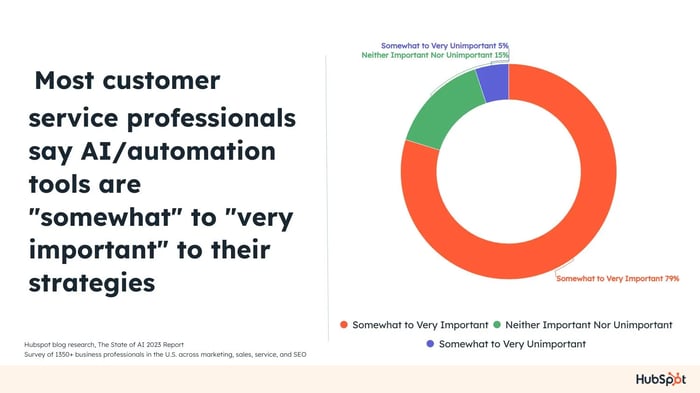
So, why is AI worth the hype? Below is a ranking of the top benefits AI users in the service field are already seeing, according to our findings.
Likewise, customer service pros reported the three most popular use cases for AI tools — routing requests to reps, collecting and analyzing customer feedback, and enabling chatbots. The almost even distribution of responses may signify that AI services are already adopted and rooted in these processes.
Retention remains top-of-mind.
Retention is still something service teams and businesses want to maintain or increase, especially with the ongoing recession news because 95% of consumers say that customer service has an impact on their brand loyalty. The latter translates into repeated purchases or word-of-mouth.
The top three factors that contribute to higher customer retention and CLV (customer lifetime value), according to the NICE study:
- Businesses have professional agents — 29%
- Consumers can access self-service online — 22%
- Customers easily get service using the digital channel of their choice — 21%
While retaining customers through downgrades or customer resources might not feel as impactful as upgrading in the moment, it's important to remember companies with defined retention strategies have been linked to solid ROI and overall growth — especially in uncertain times.
Customer service is getting more social.
Think having a basic service phone number or email will be a leg up on the competition? Unfortunately...
In a January HubSpot survey of more than 120 consumers, 64% said they regularly use social media messaging, such as Instagram Messenger, Facebook Messenger, WhatsApp, or Twitter DMs to get in contact with service teams.
In our 2023 State of Social Media Report, we revealed that 43% of companies offering customer service through DMs have a customer service rep responding to messages, while 41% ask a marketer to handle messaging and escalate major service issues to them.
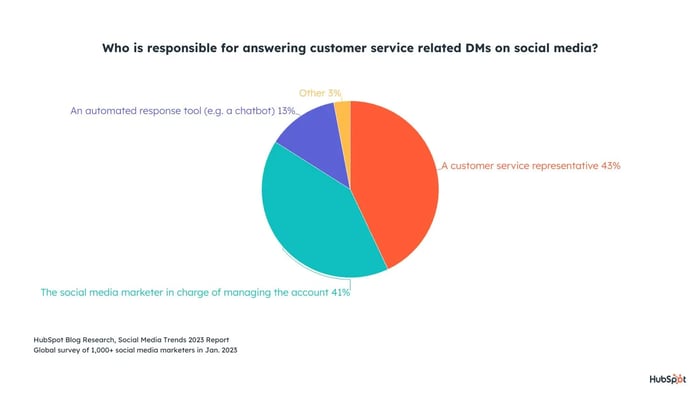
As 2023 continues, we expect to see more use of automated bots integrated into social media messaging platforms to streamline service or marketing's work there. In early 2023, 13% of the brands we researched were already doing this.
However…
CEOs from European B2B companies believe email support will still be dominant in the coming years until 2025, according to a new SuperOffice study.
Service teams need more time to work — but are expected to work faster than ever.
In 2022, a whopping 43% and 51% of agent-level respondents and high-growth and low-growth companies, respectively, said that not having enough time in the day was their biggest day-to-day challenge.
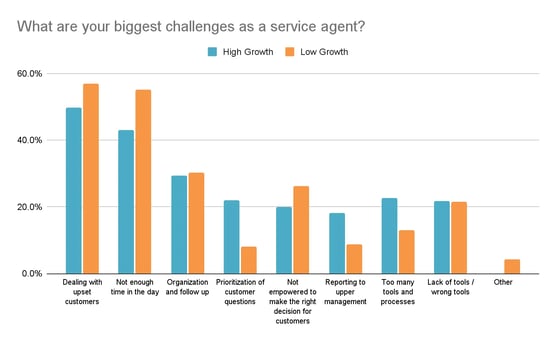
In 2023, time remains a constant struggle. In a recent HubSpot survey of consumers, 60% said they would be more loyal to a brand with a fast customer service response time.
Luckily, service teams have begun to use emerging technologies like AI and automation to adapt to continuous time pressures. In our 2023 State of AI Survey, 64% of service reps who use AI today said it enables more time to personalize and improve upon the responses they give to customers.
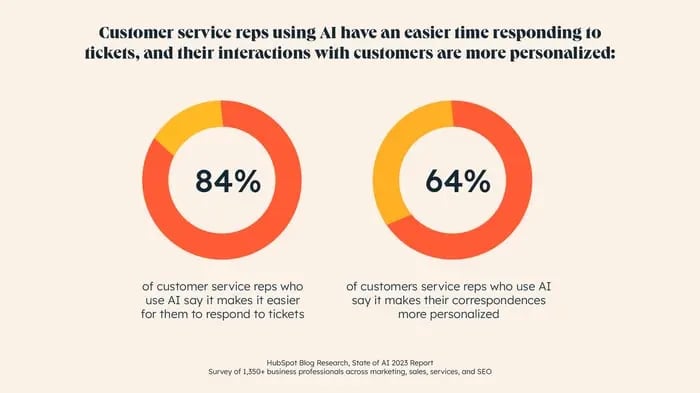
Customers have increasing expectations.
Back in 2022, a whopping 88% of reps we surveyed agreed that customers have higher expectations than they did in previous years. Meanwhile. 79% said customers are more informed than they were in the past. As the world becomes more fast-paced and hybrid, these expectations are growing.
Thus, 83% of consumers want to immediately connect with a sales rep or support agent upon contacting the company.
In most cases, customers are calling service people when they've already reviewed all the troubleshooting steps, watched a handful of how-to videos, and surfed the online knowledge bases. What they really want is someone to relate to them, listen, and actively help them with an authentic level of care. With no waiting in line.
Moving on, many findings in our State of Consumer Trends Report validated that consumers, in fact, crave authentic experiences and want to work with mission-driven companies that care about their customers.
“Since the pressure on customer service is growing, and the team's morale can be low, the managers should exude confidence and lead their teams through any obstacle. Don’t forget to publicly share any success your team achieved — be the Kris to your Kardashians,” advises Nina Novikova, head of customer support at Reply.io.
Shrinking service tech stacks will boost ROI.
Throughout the last three years, one thing became apparent:
Despite how connected we are to our computers, tablets, phones, and the world-wide-web, a lot of companies were buried in tech tools that didn't integrate, company silos, and data that didn't paint a whole picture of the business landscape. This, in turn, caused missteps that could potentially lose customers.
HubSpot called this era "The Crisis of Disconnection."
But, in 2023, service teams are beginning to catch on to the fact that streamlined and all-in-one software strategies can help reconnect them to other departments and their customers.
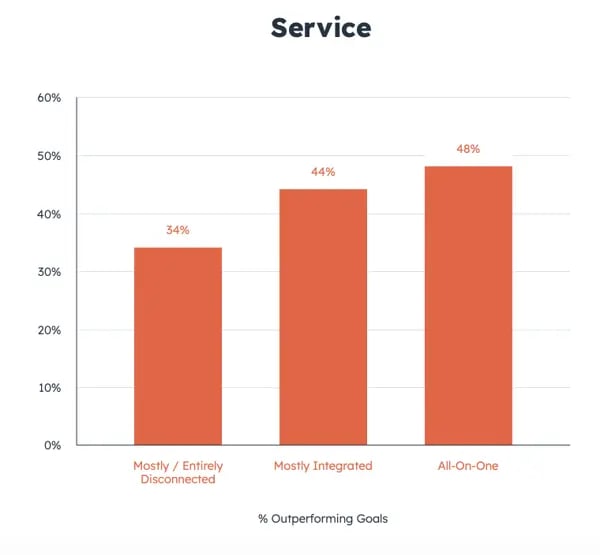
In fact, a recent HubSpot Report found that 48% of service professionals with a connected, all-in-one solution beat their 2022 goals, while 44% of professionals who considered their tools "mostly integrated" similarly outperformed.
Recommendations for Service Teams
Stay connected to your customers and other teams.
Siloes, poor data, switching between many tools, and other crises of disconnection can negatively impact you, your customer, and your company's ROI.
Be sure to know the signs of a critical disconnection, and then leverage the right tools and resources to help you stay or get on track.
“Organizations need to be able to report on these findings and answer questions like, ‘What do customer interactions with our support reps tell us about the health of our customer?’ and, ‘How can we leverage service data to identify risk early on or growth in a customer?’” says Jessica Aguilar, senior customer success manager at HubSpot.
Aguilar notes that there's a lot to glean from these interactions. Oftentimes, bloated tech stacks or misconfigured integrations with support tools can present roadblocks to harnessing this data.
“You can build out your Support pipelines through Service Hub in HubSpot to have your service efforts live in one place,” she says. “Then, teams like marketing, sales, and service not only have more visibility on their efforts but can effectively build out reporting to better understand their customers and act accordingly."
Leverage AI and automation to streamline tasks.
Aside from keeping connected with your customers and team, CX is another top priority of service professionals.
However, it takes time to build excellent and highly connected experiences. (And, as we mentioned, time is one thing reps can't get enough of.) To navigate many of these problems, teams are continuing to invest in emerging AI or automation tools like:
- Automated ticketing systems that eliminate time spent filtering and organizing service queries
- Knowledge bases, chatbots, and other resources that help customers answer their own questions.
- CRM software to help streamline customer management and relationship-building processes.
By leveraging the tools above, customer service professionals can both streamline tasks and begin to focus on bigger-picture projects, like breaking down company silos or building better customer experiences.
Furthermore, 84% of customer service pros who use AI/automation in their role report that the tools make it easier to respond to customer service requests. And 89% of AI users within CS agree that AI tools successfully prioritize CS requests in terms of urgency, according to our 2023 State of AI.
Prioritize retention and relationships.
Customers are loyal to brands that value their opinions and provide helpful, personalized experiences. And 62% of them think that businesses could offer more personalization. 59 % of consumers even want businesses to use the data they collect about them to personalize their experiences.
But guess what? Only 31% of customer agents report on the effective use of customer data to improve and personalize experiences.
And this staggering finding is at odds with 77% of business leaders recognizing deeper personalization leads to increased customer retention.
“We are heavily focused on retention, and the constant cooperation between product and customer service teams is the key,” Novikova says. “By sharing insights and perspectives, we make sure the client is heard, and the customer service teams are aware of all the product strategies. Thus, we can stay ahead of the client’s questions.”
So, bring together your CS, marketing, and sales departments to break data silos and develop unparalleled CX.
Focus on proactive behaviors, not reactive ones.
When it comes to improving your customer service experience, remember to stay proactive.
“Customers don't know what they don't know and lean on businesses and account managers or customer success managers to tell them where to get started,” says Michael Renahan, Senior Manager, Customer Success at HubSpot. "That said, a strong customer success team focuses on proactive behaviors, not reactive.”
Renahan suggests that customer success teams create a guided experience through proactive calls, emails, or in-app experiences. This will drive the best results for your company long-term.
“Customers buy software because they want to solve a pain point. That pain point, however, is just the beginning of their journey. Success adoption starts with solving for pain, then expanding into opportunity,” he says.
Track and share your successes.
The best way to justify more investment from business leaders is to show that your team is, in fact, helping them grow their customer base and increase steady revenue. Whenever possible, present your key projects, strategies, or metrics.
If you're a leader, make sure your results and your team's results are shared with decision-makers on your company's wider leadership team.
If you're a rep or agent, be sure to share your accomplishments with your manager, colleagues, or internal communications to ensure the wider company knows how you're successfully retaining, gaining, and delighting loyal customers.
How Companies Can Solve for the Customer in 2024
Whether you're a leader or a service professional aiming to level up your work, tools like HubSpot's Service Hub and CRM can keep your team and your customers connected and more able to take on the changing customer service landscape. Learn more about these tools by clicking the banner below.
Editor's note: This article was originally published March 2022 and has since been updated for comprehensiveness.











